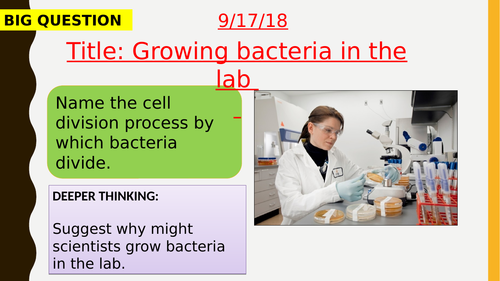

NB: This is a BIOLOGY (SEPARATES) ONLY lesson
Growing bacteria in the lab lesson created in accordance to the NEW AQA Specification (9-1). Includes: slide animations, embedded videos, differentiated questions and answers have also been included within the slides. This resource is NOT suitable for combined science students.
AQA spec link: 4.1.1.6
Relevant chapter: B5-Communicable diseases . AQA Biology third edition textbook-Page 78-79.
Bacteria multiply by simple cell division
(binary fission) as often as once every 20 minutes if they have enough nutrients and a suitable temperature.
Bacteria can be grown in a nutrient broth solution or as colonies on an agar gel plate.
Uncontaminated cultures of microorganisms are required for investigating the action of disinfectants and antibiotics.
Students should be able to describe how to prepare an uncontaminated culture using aseptic technique.
They should be able to explain why:
• Petri dishes and culture media must be sterilised before use to kill unwanted microorganisms
• inoculating loops used to transfer microorganisms to the media must be sterilised by passing them through a flame
• the lid of the Petri dish should be secured with adhesive tape to prevent microorganisms from the air contaminating the culture, and stored upside down
• in school and college laboratories, cultures should be incubated at a maximum temperature of 25 °C.
Get this resource as part of a bundle and save up to 35%
A bundle is a package of resources grouped together to teach a particular topic, or a series of lessons, in one place.
AQA Biology-SEPARATE topics PAPER 1 ONLY
Separate Sciences B5.3, B5.4, B5.10 & B5.11 B6.5 & B6.6
AQA new specification-B5 Communicable diseases-Separate science bundle
This bundle only contains the content for SEPARATE science (BIOLOGY ONLY) students. It includes the B5 unit-communicable diseases. All lessons have been done in accordance to the specification requirements. Videos have been embedded for ease of use, and printer friendly resources attached. Search the individual lessons for more information on the lesson content. Save 35% by purchasing this bundle :) Lesson 1-Heath and disease Lesson 2-Pathogens and disease Lesson 3-Growing bacteria in the lab Lesson 4-RP 2 Microbiology Lesson 5-Preventing bacterial growth Lesson 6-Preventing infections Lesson 7-Viral and bacterial diseases Lesson 8-Diseases caused by fungi and protist Lesson 9-Human defense responses Lesson 10-More about plant diseases Lesson 11-Plant defence responses
Something went wrong, please try again later.
This resource hasn't been reviewed yet
To ensure quality for our reviews, only customers who have purchased this resource can review it
Report this resourceto let us know if it violates our terms and conditions.
Our customer service team will review your report and will be in touch.
